ICE
Case Studies Number
216, May, 2007
by Andriy Shevtsov
1. Abstract
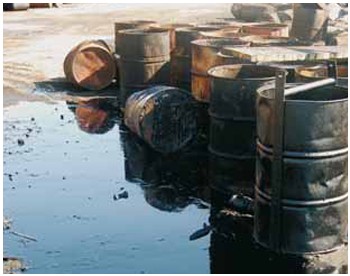 This case study describes the
environmental damage caused by the conflict between Israel and Lebanese Hizbollah
forces in July 2006. The conflict began when Hizbollah militants crossed into
the Israeli territory and attacked Israeli forces. Israel responded by launching
massive air strikes and combat operations in Southern Lebanon. After a month
of fierce fighting the conflict caused significant damage to the environment
in the region. A massive oil spill from the bombing of Jiyyeh power plant significantly
polluted the coastline in Lebanon and several neighboring countries. Israeli
bombing led to hydrocarbon contamination, groundwater contamination, and up
to a million of unexploded cluster bombs spread throughout Lebanon. Hezbollah
rocket attacks started forest fires in northern Israel that destroyed an estimated
3,000 acres of forest.
This case study describes the
environmental damage caused by the conflict between Israel and Lebanese Hizbollah
forces in July 2006. The conflict began when Hizbollah militants crossed into
the Israeli territory and attacked Israeli forces. Israel responded by launching
massive air strikes and combat operations in Southern Lebanon. After a month
of fierce fighting the conflict caused significant damage to the environment
in the region. A massive oil spill from the bombing of Jiyyeh power plant significantly
polluted the coastline in Lebanon and several neighboring countries. Israeli
bombing led to hydrocarbon contamination, groundwater contamination, and up
to a million of unexploded cluster bombs spread throughout Lebanon. Hezbollah
rocket attacks started forest fires in northern Israel that destroyed an estimated
3,000 acres of forest.
2. Description
The hostilities on the Israeli-Lebanese border
started on 12 July, 2006 when Hizbollah, launched several rockets towards Israel’s
territory, crossed the border into Israel and attacked an Israeli patrol, capturing
two soldiers, and killing three (UNIFIL). In response to the attack, Israel
launched a number of artillery and air strikes on targets across southern Lebanon,
destroying bridges, highways, and airports. Hizbollah responded by launching
rockets against northern Israeli cities and Israel followed with a full ground
offensive of southern Lebanon (“The Israel-Lebanon Crisis”).
At the beginning of the crisis the UN Security
Council was not able to reach consensus on how to end the hostilities. Secretary-General
Kofi Annan called for immediate ceasefire, supported by Lebanon’s government
and many Arab states. The US, on the other side, was more supportive of Israel
and its right to self-defense. European countries remained somewhat neutral,
condemning Hizbollah attacks, yet urging Israel to maintain proportionality
of its response (“The Israel-Lebanon Crisis”).
Following a line of negotiations, on 11 August
2006 the UN Security Council finally passed resolution 1701 that called for
immediate cessation of all military operations by both sides to the conflict.
Israel was to withdraw from southern Lebanon and Hizbollah was to cease its
rocket attacks (“The Israel-Lebanon Crisis”). The Lebanese Government
agreed to deploy 15,000 troops in Southern Lebanon and UNIFIL extended its presence
from 2,000 to 15,000 troops to support Lebanese forces in monitoring the ceasefire
(“The Israel-Lebanon Crisis”).
As a result of the conflict, more than 1,100
Lebanese died, more than 4,000 had been injured, and over one million Lebanese
were displaced for the duration of the war. The conflict caused tremendous damage
to Lebanon’s infrastructure. As a result of Israeli bombing, 80 bridges,
900 factories and commercial buildings, airports and an estimated 15,000 homes
were destroyed. On the Israeli side, the conflict led to death of 43 civilians
and 117 IDF soldiers. An estimated 4,000 Hizbollah rockets landed in Israel
during the conflict; 300,000 Israelis were displaced and more than a million
had to live in shelters to avoid rocket attacks (UNIFIL).
In addition to causing over a thousand deaths
and immense human suffering, the conflict had been extraordinary damaging to
the environment. In addition to the most high profile case of the immense oil
spill resulted from the bombing of Jiyyeh plant, the conflict caused large areas
of agricultural land to be contaminated with unexploded ordinance, and ground
and surface water pollution (UNEP 6-7).
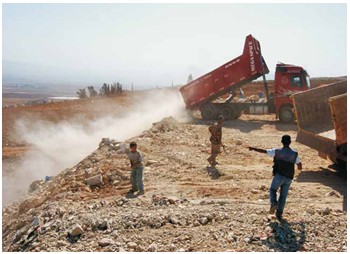
3. Duration
12 July 2006 – 11 August 2006
4. Location
Continent: Asia
Region: Middle East
Countries: Israel, Lebanon
5. Actors
Israel Defense Forces (IDF)
Lebanese Hezbollah

6. Type of Environmental Problem: Pollution Sea [POLS]
The 34-day war between Israel
and Hezbollah affected surrounding environment in a number of ways. The environmental
implications of the conflict ranged from air and water pollution to forest fires
and waste problems and have extended beyond the territory of the two countries,
often affecting several countries in the region.
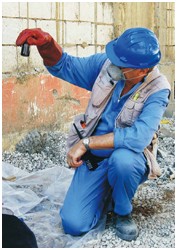
1. Sea Pollution: The most
well-known and one of the most serious cases of the environmental damage caused
by the Israel-Lebanon conflict is the massive oil spill that resulted from the
Israeli bombing of the fuel tanks at the Jiyyeh power plant in Lebanon. It is
estimated that between 10,000 and 35,000 metric tons of oil have spilled into
the sea (“Oil Spill”). The spill affected an estimated 150 kilometers
of Lebanese coastline, including beaches, ports and marinas. While most of the
oil released burned out or spilled into the sea, it is estimated that significant
amounts also seeped in the rock underneath that has potential to contaminate
groundwater wells in the area (UNEP 45).
2. Air Pollution: The strike
on the fuel tanks resulted in massive fires that burned for up to 27 days. The
smoke from the fires released a number of pollutant into the atmosphere, including
soot, particulate matter, carbon monoxide, and methane. A combination of these
pollutants is likely to cause respiratory problems for local residents (UNEP
45).
3. Land Pollution: In addition
to the oil spill at the Jiyyeh plant, several other sites such as Beirut airport,
several industrial factories, and petrol stations showed various levels of hydrocarbon
contamination (UNEP 160).
4. Groundwater Contamination: Groundwater was also contaminated in several sites due to chemical spills, as
in the case of Ghabris detergent factory in Tyre where bombing caused large
quantities of chemicals being spilled into soil and water.
5. Cluster bombs: IDF used
cluster bombs throughout the conflict. Cluster bombs contain several hundreds
of smaller sub-munitions or bomblets in them and are usually dropped from the
air. The bomblets often fail to detonate on impact and remain on the ground
until further contact with humans or environment. One cluster bomb releases
enough bomblets to contaminate an area of up to eight acres (UNEP 150). The
unexploded bomblets present great hazard to civilian population and restrict
access to agricultural land. It is estimated that there were up to one million
unexploded bomblets in Lebanon after the conflict (UNEP 154).
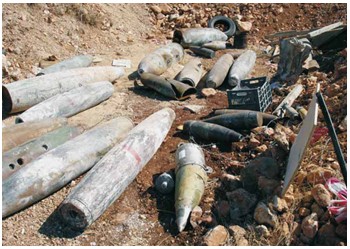
6. Additional environmental problems: Some other
environmental problems in Lebanon that were caused by the conflict include solid
waste management, hazardous healthcare waste contamination, and damaged sanitation
and wastewater infrastructure.
On the Israel’s side, most of the environmental
damage resulted from Hezbollah rocket attacks that started several forest fires
in northern Israel. It is estimated that as much as 3,000 acres of forest in
Israel have been damaged due to the rocket attacks (Kraft). In addition, Israel
had to modify parts of natural landscape in the northern Israel in order to
build new military bases and patrol roads (Heilman).
7. Type of Habitat: Temperate
Lebanon has temperate Mediterranean climate
that ranges from mild to cool. Winters are generally wet, while summers are
dry and hot (“CIA World Factbook”). Due to topological variations
climate differs in parts of Lebanon. On the coast, summers are hot and humid
with little or no rain while winters are generous in rainfall and relatively
warm due to a hot wind blowing from the Egyptian desert. In the mountainous
parts of Lebanon, winters are colder with more rainfall and snow while summers
are dry and hot (Library of Congress).
8. Act and Harm Sites: Israel, Lebanon, and Commons
Sites of environmental harm that resulted from
the conflict are present in several countries in the region. While most of the
damage is certainly concentrated in Southern Lebanon and Northern Israel, several
other countries were also affected by the conflict. For example, the massive
oil spill from the Jiyyeh power plant affected not only Lebanon and Israel,
but also the coastline in other neighboring countries, most notably Syria, Turkey
and Cyprus (“Oil Spill”).

9. Type of Conflict: War
The nature of conflict between Hezbollah and
Israel in the summer of 2006 can be categorized as a war. However, it has to
be mentioned that the conflict does not fit within traditional categories of
interstate vs. intrastate conflicts. The conflict took place between Israel
– a state, on the one side, and Hezbollah – a political Islamist
group with military and civilian arm, on the other. Although Hezbollah has representatives
in the Lebanon’s Parliament and is politically involved in the country,
its actions were not state-sponsored and cannot be attributed to Lebanon as
a nation-state. Therefore, the conflict can be categorized as a war between
a state and an external non-state actor (Human Rights Watch).
10. Level of Conflict: Low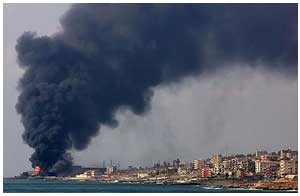
The level of conflict between Hezbollah and
Israel is comparatively low. On the Lebanon’s side, over one million people
were displaced for the duration of the war. The conflict caused tremendous damage
to Lebanon’s infrastructure. As a result of the bombing, 80 bridges, 900
factories and commercial buildings, airports and an estimated 15,000 homes were
destroyed.
On the Israel’s side, the conflict displaced
over 300,000 for the duration of the war and more than a million had to live
in shelters to avoid rocket attacks. An estimated 4,000 Hizbollah rockets landed
in Israel during the conflict, causing damage to infrastructure and environment
(UNIFIL).
11. Fatality Level of Dispute (military and civilian fatalities): 1,260
As a result of the conflict, more than 1,100
Lebanese died and more than 4,000 were wounded, mostly as result of the air
bombing campaigns. On the Israeli side, the conflict led to the death of 43
civilians, mostly as a result of rocket attacks, and 117 IDF soldiers (UNIFIL).

12. Environment-Conflict Link and Dynamics: Direct
The 2006 Israel-Lebanon conflict is characterized by a direct causal relationship between conflict and environment. The fighting between the two parties was mostly done by means of bombing campaigns on the Israeli side and rocket attacks on the Hezbollah’s side. Israeli bombing led to hydrocarbon contamination of soil and water in Lebanon. Most known environmental case was Israel’s strike on Jiyyeh plant in Lebanon that caused a massive oil spill and air pollution from fires that lasted for many days. The oil spill led to coastline pollution in several countries, polluted rock underneath the plant and contaminated groundwater. In addition, Israeli bombing left a large amount of unexploded ordinance throughout Lebanon, most notably up to one million of unexploded cluster bombs. Hezbollah rocket attacks caused several forest fires in Israel. Israel also had to alter some of its natural landscape in the North to accommodate new military bases.
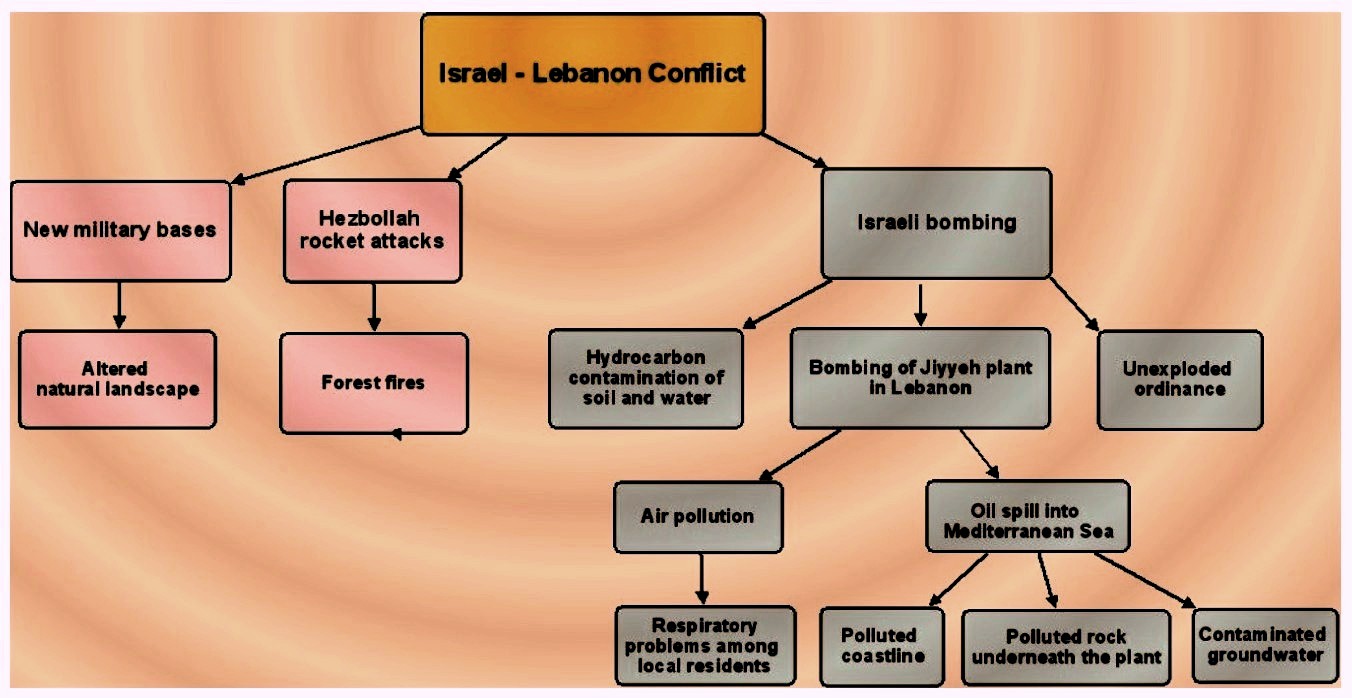
13. Level of Strategic Interest: Regional
14. Outcome of Dispute: Compromise
On 11 August 2006 the UN Security Council passed
resolution 1701 that called for immediate cessation of all military operations
by both sides to the conflict. Israel was to withdraw from southern Lebanon
and Hezbollah was to cease its rocket attacks (The Israel-Lebanon Crisis). Lebanese
Government agreed to deploy 15,000 troops in Southern Lebanon and UNIFIL extended
its presence from 2,000 to 15,000 troops to support Lebanese forces in monitoring
the ceasefire (UNIFIL).

15. Related ICE Cases
Three different searches were conducted in order to find related ICE and TED cases. The first search looked at the cases picked by the ICE expert system using “Lebanon” as a keyword. The second search looked at all cases in the database that took place in the Middle East and involved sea pollution as an environmental issue. For the third search the following case attributes were entered into the system:
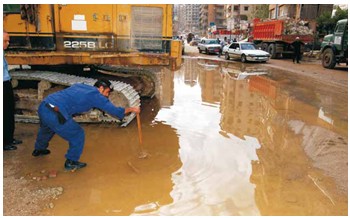
Continent: Mideast
Regions: Middle East in Asia
Country: Lebanon
Habitat: Temperate
Environmental problem: Sea pollution
Scope: Bilateral
Trigger: Military
Type: War
Outcome: Compromise
Level of Conflict: Low
Beginning year: Modern
Durations: 0-10 years
Following the quantitative search, a qualitative review of the cases was performed and the following cases were selected as the most relevant to the case of Environmental Implications of the 2006 Israel-Lebanon conflict:
Lebanon – landmine (Case 116): According
to the UN there are more than 100 million unexploded landmines in more than
60 countries. More than 20,000 people are killed by landmines per year of which
the majority are children. It costs $3 to make a landmine but hundreds of times
more to dismantle it. In Lebanon, since the beginning of the war in 1975, more
than 1,200 Lebanese were killed because of the Israeli Landmines. This does
not include the thousands that were killed also because of the Lebanese militias
the Palestinians as well as the Syrians. This is of course a high number in
proportion to the Lebanese population of 3.5 million people.
Cedars of Lebanon (Case 59): From 2,600 B.C.
to 138 A.D., various cultures populated the Middle East including the Canaanites,
Aegeans, Armenians, and Phoenicians. During this time, these peoples gradually
finished the destruction of the famed Cedars of Lebanon that Gilgamesh earlier
had begun. For nearly three millennia, cedar and other timbers from Lebanon
served a variety of needs: fuel, ship material, building material, and household
usage. Through cities such as Sidon and Tyre, wood was also exported to Palestine
and Egypt, areas with large populations and relatively little forest cover.
The result was large-scale deforestation. The scarcity of trees was so noticeable
that, over time, the few remaining tall trees even became objects of worship.
Lebanon Civil War and Waste Dumping (Case 65):
An Italian firm, Jelly Wax, allegedly shipped over 2,400 tones of chemical wastes
to Lebanon between September, 1987 and June, 1988 through ports outside Lebanese
government control. On June 5, 1988, barrels of Italian hazardous wastes were
discovered on the Kerswan shore, north of Beirut. Soon barrels that had been
dumped at sea were discovered by fishermen in the southern port of Tyre, to
the south of Beirut. An additional 2,411 tones of wastes were discovered in
East Beirut and Ghazir, 25 kilometers north of Beirut. After initial government
inability to force Rome to remove the wastes, threats by Lebanese terrorist
organizations led to Italian clean-up efforts.
Litani River and Israel-Lebanon (Case 14): In
the Middle East, the supply of water is much less than its demand, thereby resulting
in conflict over it. This is true for Israel and Lebanon, where there have been
struggles, although not always armed, for the waters of the Litani River. At
this point, Israel occupies southern Lebanon. Part of the Litani is located
in this region. There are conflicting reports and conclusions over whether or
not Israel is using the Litani. There is also a verbal struggle over which country
needs the Litani more, could make best use of it, and who, therefore, should
develop their use of the Litani. Although there is not an armed struggle over
it now, it has been involved in armed struggles in the past (in the 1967 war,
and in 1982) and it is conceivable that in the future the struggles over it
may become armed.
Kuwait (Case 9): The environment always seems
to be the victim of war, and the scenario was no different in the case of the
Persian Gulf Crisis from 1990 to early 1991. The ecological and economic impact
of the Gulf War began on August 2, 1990 when Iraq invaded Kuwait and the full
impact probably will not be realized in the near future. What can be determined
is that Kuwait suffered severe losses not only to its oil industry, but also
to its ecological system. The scale of damage was enormous, ranging from destruction
cased by oil fires and oil spills, to economic decline for the Kuwaiti oil industry.
This paper assesses the environmental and economic consequences of the Gulf
War on Kuwait.
16. Relevant Websites and Literature
A Country Case Study: Lebanon. Library of Congress.
http://lcweb2.loc.gov/cgi-bin/query/r?frd/cstdy:@field(DOCID+lb0041)
Djerejian, Edward P. 2006. From Conflict Management
to Conflict Resolution. Foreign Affairs November/December: 41-48.
Heilman, Uriel. War in North Leaves Deep Scar on
Israel’s Forests and Wildlife. JTO News August 8, 2006.
Kraft, Dina. Dry Forests in Northern Israel Are
Damaged as Hezbollah’s Rocket Attacks Ignite Fires. New York Times August
8, 2006.
Lebanon. CIA World Factbook 2006. Available at
<<https://www.cia.gov/cia/publications/factbook/geos/le.html#Geo> >
Lebanon: Pose Conflict Environmental Assessment.
2006. Nairobi, Kenya: United Nations Environment Programme.
Oil Spill. 2006. Intelligence Report 29(32): 1
The Israel-Lebanon Crisis. 2006. International
Debates 4(6):1-1.
The Israel-Lebanon Timeline. 2006. International
Debates 4(6)
UNEP – United Nations Environmental Programme.
2007. Lebanon: Post-Conflict Environmental Assessment. Nairobi, Kenya.
UNIFIL – United Nations Interim Force in
Lebanon. 2006. Background. Available at <http://www.un.org/Depts/dpko/missions/unifil/background.html>

May, 2007
 This case study describes the
environmental damage caused by the conflict between Israel and Lebanese Hizbollah
forces in July 2006. The conflict began when Hizbollah militants crossed into
the Israeli territory and attacked Israeli forces. Israel responded by launching
massive air strikes and combat operations in Southern Lebanon. After a month
of fierce fighting the conflict caused significant damage to the environment
in the region. A massive oil spill from the bombing of Jiyyeh power plant significantly
polluted the coastline in Lebanon and several neighboring countries. Israeli
bombing led to hydrocarbon contamination, groundwater contamination, and up
to a million of unexploded cluster bombs spread throughout Lebanon. Hezbollah
rocket attacks started forest fires in northern Israel that destroyed an estimated
3,000 acres of forest.
This case study describes the
environmental damage caused by the conflict between Israel and Lebanese Hizbollah
forces in July 2006. The conflict began when Hizbollah militants crossed into
the Israeli territory and attacked Israeli forces. Israel responded by launching
massive air strikes and combat operations in Southern Lebanon. After a month
of fierce fighting the conflict caused significant damage to the environment
in the region. A massive oil spill from the bombing of Jiyyeh power plant significantly
polluted the coastline in Lebanon and several neighboring countries. Israeli
bombing led to hydrocarbon contamination, groundwater contamination, and up
to a million of unexploded cluster bombs spread throughout Lebanon. Hezbollah
rocket attacks started forest fires in northern Israel that destroyed an estimated
3,000 acres of forest. 




